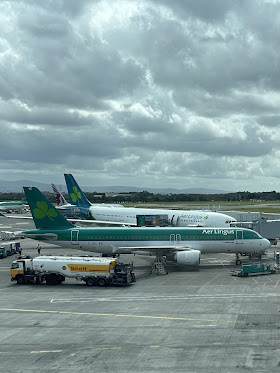I have long wanted to travel to Ireland, but it never rose to the top of my husband's list. This year we had trips scheduled in March and December, with nothing planned for the summer. Bob just couldn't imagine a summer without travel, so Ireland rose to the top as a carrot to convince me to add one more big trip to the year. It worked.
In preparation for the trip, we started watching every movie set in or about Ireland that we could find, and we read a few books as well. Very quickly we discovered that we knew embarrassingly little about Irish history. Here are just a few key things we learned.
• The
island of Ireland has two parts.
- Five-sixths of it is the Republic of Ireland (all the colorful sections in the map above), also officially known as Ireland. It is an independent country with 5.1 million people. When we Americans say "Ireland," this is what we mean.
- The remaining one-sixth is Northern Ireland (the gray section in the map), which is part of Great Britain and has a population of 1.9 million.
• Between 1916 and 1921, Irish republicans (or the Irish Republican Army - IRA) fought for independence from Great Britain, but Irish Ulster loyalists and British forces fought to keep Ireland as part of Great Britain. The first main revolt was the Easter Rising of 1916, but it was put down in a week. Ireland's breakaway government declared Irish independence in January 1919. Tensions escalated over the next few years, with much of the conflict occurring in County Cork, Dublin, and Belfast. A treaty signed in December 1921 ended British rule of most of Ireland, but Northern Ireland remained within the United Kingdom and under British control. In spite of the treaty, fighting continued through 1922.
• "The Troubles" is a euphemistic term for the period of conflict in Northern Ireland that lasted from the late 1960s to 1998. When I think of conflict in Ireland, this is what I think of. I always thought it was a war between the Catholics and Protestants, but that's not entirely true. It really was about whether Northern Ireland should be British or Irish. It so happened that the Unionists, or those who favored remaining with Great Britain, were mostly Protestants (as is true of most British subjects), and the Irish nationalists or republicans were mostly Catholics. The conflict began as a campaign to end discrimination against the Catholic-nationalist minority in Northern Ireland, and it spiraled out of control from there. The IRA that had been active in the Irish fight for independence 50+ years earlier was also active in this conflict, and that's where I became familiar with it.
Once we arrived in Ireland, we learned a few more things.
• We never saw corned beef and cabbage on any menu in Ireland. Apparently, that's an Irish-American thing. Their main ethnic food seems to be beef stew. There is a lot of meat in their diet--sausage, bacon, and some lamb and chicken. They eat a lot of potatoes--no surprise there.
• We saw references to leprechauns only in tourists shops. Shocking. One Irish guide blamed the movie Darby O'Gill and the Little People for the popularity of leprechauns among tourists. I would add that Lucky Charms has also done its part.
• Northern Ireland has its very own Protestant church, the Church of Ireland.
• The Irish had their own language, Irish Gaelic, that was Ireland's primary language until the 19th century, when English gradually took over. However, all the signage on the island is in both English and Irish, and Irish is still taught in the schools.
• Guinness dominates the drink market. Everything seems somehow to be related to the brewery. It was impossible to walk down a shopping street or go into a restaurant without seeing the Guinness trademark. Guinness stout must be served in Guinness pint glasses, and there is a specific temperature and pouring method that is strongly recommended. There is even a Guinness Zero, the "zero" referring to the amount of alcohol. We tried it and found it awful.
We learned a lot more as we traveled, but I'll get into that in future posts. For now, if you want to have some fun preparing for a trip to Ireland, here is a list of movies that we watched either on Netflix or Amazon Prime,
These four historical dramas were fantastic. I heartily recommend them all for anyone traveling to Ireland.
There are many well-done movies that draw on the culture of Ireland:
Of course, we watched several cheesy romances:
I'm not sure what to say about this one, other than that I liked it when I was about nine years old and Sean Connery is the leading man. Other than that, there isn't much to recommend it. I think Bob made it about a third of the way through.
This 1952 movie was a little better, and seeing John Wayne in something other than a Western was kind of fun.
And finally, we tried and failed to get into this Netflix series. We watched one or two episodes and decided to skip the rest.
Armed with our vast knowledge gained mostly from movies (how American of us), we were ready to head to Ireland!














































